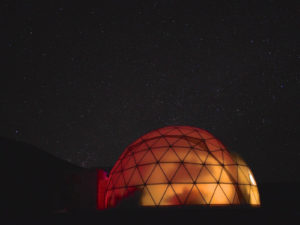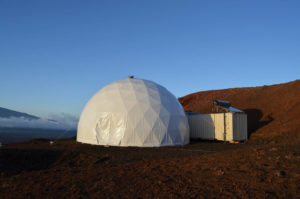
Mars simulation crew spends eight months in habitat supplied by Pacific Domes.
It may be decades or more before the first tent is erected on Mars, but one tent manufacturer is contributing to a project that will help humans get there.
In October 2014, a six-member crew of the NASA-funded Hawai‘i Space Exploration Analog and Simulation (HI-SEAS) experiment entered a habitat supplied by Pacific Domes of Ashland, Ore. They will emerge this June—eight months later.
The purpose of HI-SEAS is to study the social, interpersonal and cognitive factors that affect team performance over an extended period of time in an isolated environment. Two previous missions lasted four months each.
The habitat is located at an elevation of about 8,000 feet in an abandoned quarry on the northern slope of Mauna Loa volcano. Crew members, who are also conducting their own experiments, have no real-time communication with the outside world and can only leave the dome if they don space suits.
The dome was chosen because it has a number of similarities to potential Martian habitats: the circular floor plan maximizes space and minimizes weight, and a domed structure tends to fit better into rockets, says crew member Zak Wilson in a blog post.
 “Inflatable habitats are one potential living structure, which would likely be dome shaped,” Wilson says. “For HI-SEAS, the practical considerations of transporting the habitat to its remote location and leaving minimal impact after removal were also important factors.”
“Inflatable habitats are one potential living structure, which would likely be dome shaped,” Wilson says. “For HI-SEAS, the practical considerations of transporting the habitat to its remote location and leaving minimal impact after removal were also important factors.”
The dome is 36 feet in diameter, with a ground floor area of nearly 1,000 square feet for a dining room, kitchen, lab, bathroom, office, exercise area and movie theater. The 420-square-foot loft includes six bedrooms and a second bathroom.
“While it isn’t a big space for six people, its high ceilings and translucent skin make it feel spacious and open,” Wilson says.
The crew and the dome were put to the test in their first week when Hurricane Ada made a close pass south of the island. The crew conducted an EVA (extravehicular activity) to check the habitat for potential issues and considered previous experience based on Hurricane Iselle, during which the sheltered location was subjected to only moderate winds.
“The structural limit of the habitat is in the range of 70 mph, so the decision was made to stay through the storm,” Wilson says. “The last thing we wanted was to leave just as we were getting settled in and expecting to be here for eight months.
“Once that decision was made, we prepared the shipping container that is attached to the habitat with water, food and blankets should we have needed to shelter in there,” Wilson continues. “During the storm itself the habitat felt totally solid and there was no concern about needing to evacuate. The biggest issue for us was the lack of sun since the main power source for the habitat is solar-charged batteries; we had to utilize the hydrogen fuel cell and gas generator backups following the storm.”
 TEXTILES.ORG
TEXTILES.ORG


